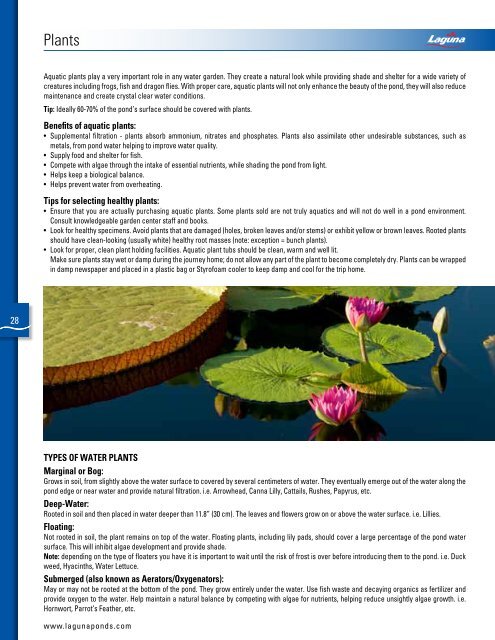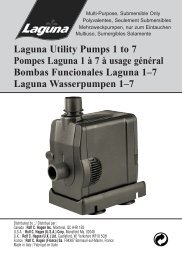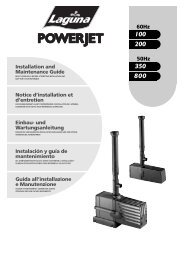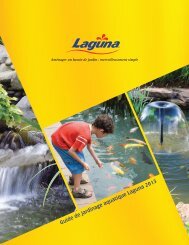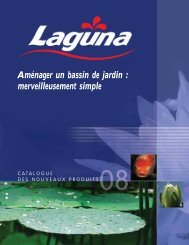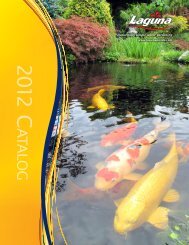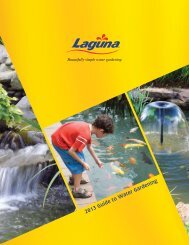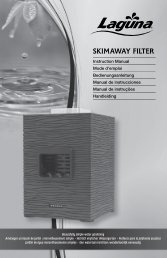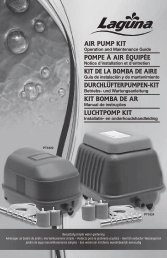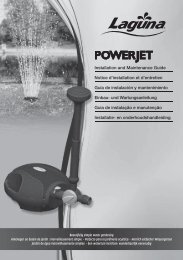Product Knowledge Care Guide 2012 - Hagen - Rolf C. Hagen Inc.
Product Knowledge Care Guide 2012 - Hagen - Rolf C. Hagen Inc.
Product Knowledge Care Guide 2012 - Hagen - Rolf C. Hagen Inc.
Create successful ePaper yourself
Turn your PDF publications into a flip-book with our unique Google optimized e-Paper software.
Plants<br />
Aquatic plants play a very important role in any water garden. They create a natural look while providing shade and shelter for a wide variety of<br />
creatures including frogs, fish and dragon flies. With proper care, aquatic plants will not only enhance the beauty of the pond, they will also reduce<br />
maintenance and create crystal clear water conditions.<br />
Tip: Ideally 60-70% of the pond’s surface should be covered with plants.<br />
Benefits of aquatic plants:<br />
• Supplemental filtration - plants absorb ammonium, nitrates and phosphates. Plants also assimilate other undesirable substances, such as<br />
metals, from pond water helping to improve water quality.<br />
• Supply food and shelter for fish.<br />
• Compete with algae through the intake of essential nutrients, while shading the pond from light.<br />
• Helps keep a biological balance.<br />
• Helps prevent water from overheating.<br />
Tips for selecting healthy plants:<br />
• Ensure that you are actually purchasing aquatic plants. Some plants sold are not truly aquatics and will not do well in a pond environment.<br />
Consult knowledgeable garden center staff and books.<br />
• Look for healthy specimens. Avoid plants that are damaged (holes, broken leaves and/or stems) or exhibit yellow or brown leaves. rooted plants<br />
should have clean-looking (usually white) healthy root masses (note: exception = bunch plants).<br />
• Look for proper, clean plant holding facilities. Aquatic plant tubs should be clean, warm and well lit.<br />
Make sure plants stay wet or damp during the journey home; do not allow any part of the plant to become completely dry. Plants can be wrapped<br />
in damp newspaper and placed in a plastic bag or Styrofoam cooler to keep damp and cool for the trip home.<br />
28<br />
Types of Water Plants<br />
Marginal or Bog:<br />
Grows in soil, from slightly above the water surface to covered by several centimeters of water. They eventually emerge out of the water along the<br />
pond edge or near water and provide natural filtration. i.e. Arrowhead, Canna Lilly, Cattails, Rushes, Papyrus, etc.<br />
Deep-Water:<br />
Rooted in soil and then placed in water deeper than 11.8” (30 cm). The leaves and flowers grow on or above the water surface. i.e. Lillies.<br />
Floating:<br />
Not rooted in soil, the plant remains on top of the water. Floating plants, including lily pads, should cover a large percentage of the pond water<br />
surface. This will inhibit algae development and provide shade.<br />
Note: depending on the type of floaters you have it is important to wait until the risk of frost is over before introducing them to the pond. i.e. Duck<br />
weed, Hyacinths, Water Lettuce.<br />
Submerged (also known as Aerators/Oxygenators):<br />
May or may not be rooted at the bottom of the pond. They grow entirely under the water. Use fish waste and decaying organics as fertilizer and<br />
provide oxygen to the water. Help maintain a natural balance by competing with algae for nutrients, helping reduce unsightly algae growth. i.e.<br />
Hornwort, Parrot’s Feather, etc.<br />
www.lagunaponds.com


